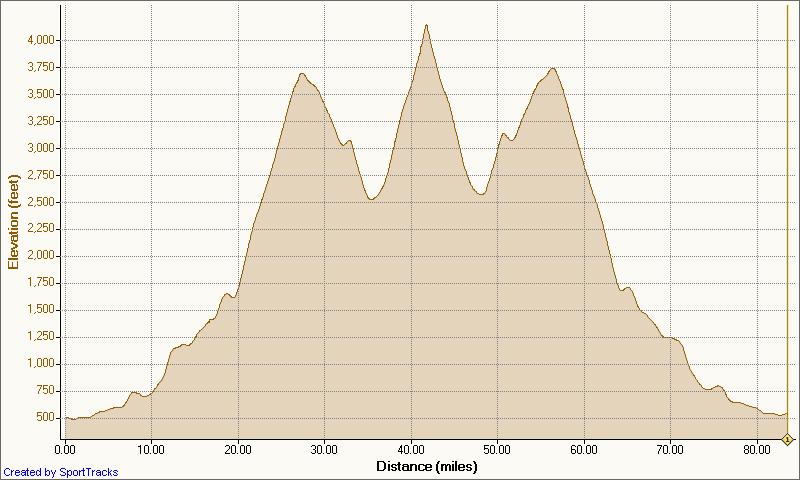
After deciding not to do the full Flying Wheels route this year, I wanted a substitute, and I decided to journey south to Castle Rock to ride Tour de Blast. My wife came along to ride the 30, and planned to do the full 82.
We left Friday afternoon at 2:30, and spent a full 4 hours getting down to Castle Rock. It’s quite a ways even if there is no traffic, which of course never happens around here any more. As much as I hate getting up early to ride, I would almost prefer to do that and miss the traffic. We stayed in the TimberLake Inn in Castle Rock and had a decent mexican dinner that night.
We woke up the next morning at 6AM, and I had a wonderful meal of a chocolate brownie clif bar, some blueberries, and a glass of water. I’ve been eating low (er) carb, and I’m still trying to figure out what I want to eat before a ride and didn’t plan well ahead of time, so it was whatever I could find it the store.
We left the hotel at around 7 and got to the start at maybe 7:25, parking in the baseball outfield. Then it was a walk to pick up our packets, a walk back, and I headed out.
Well, not quite; I spent a lot of time trying to decide what to wear and what to carry; the ride has a reputation of cold (and wet) at the top, and even though the forecast was decent it tends to be windy up there. I settled on arm warmers, no leg warmers, summer gloves, and I couldn’t decide on whether to carry my stuffable vest or my stuffable jacket, so I ended up carrying both. Plus phone, cheez-it’s and electrolyte tablets.
The ride profile looks like this:

I like to break rides into sections so I can keep them straight in my mind. For this ride there is:
- Warmup – the first 18 miles or so, which has a little over 1000′ of up.
- Elk Rock climb – 2200′ of up over 7.7 miles
- Descent + Johnson Ridge climb – 1650′ over 5.7 miles
- Descent + Elk Rock backside – 1400′ (ish) over about 8 miles
- Return to start: 3250′ down over 27 miles.
Here’s a 3d view of the route:
Warmup
I am just warm enough as I spin out of town with my stuffable vest on. We have a little flat, and then slowly start to climb up; there’s a lot of road in the 1-2% range, with a few kickers in the 6% range. I pass quite a few people, but since this is a three-route ride (there is a 30 and a 52 variant), that doesn’t really mean much. My legs feel decidedly meh and my stomach is a bit weird, but I’m okay overall. I’m trying to climb at about 175 watts, which is a pretty good “all day” pace for me generally. I push it up to 225 on one of the kickers, and feel a little bit better, which is a good sign.
At 15 miles we hit the first rest stop; I have drank maybe a third of my two bottles so I just keep going. Right near the 20 mile mark, we hit the start of the Elk Ridge climb.
You can always tell when the highway engineers got involved when you are riding in the mountains, because the gradient is typically arrow-straight. You wind around, you go over bridges, but the gradient is very constant, at about 5%, with a little over and a little under in places. I start at about 200 watts but decide that’s a little too high, so I drop down to about 180, and average 181 watts for the whole climb. My vertical meters per hour is a disappointing 550, but I do have a couple of significant climbs in front of me.
The climb itself is okay; the road itself is chipseal but they nicely decided to leave a little margin on the shoulders uncoated, so there is generally smooth surface to ride on. The bridge are big and long and provide either beautiful views or slightly scary heights depending on your perspective.
I pass people, people pass me, and I spent a bit of time chatting with those who are close to my speed. 70 minutes or so later, I hit the Elk Rock rest area. My stomach is still feeling a bit weird on my electrolyte drink, so I fill up my empty bottle with water, have a couple of potatoes with salt, skip the grilled hot dogs, and head back out.
Johnson Ridge
A short bit of up and I find myself on the Elk Rock descent. It’s a nice descent, broken in two by a short and easy (2%) uphill section, with a couple of sweeping turns. Most of the time I spend in the low 30s, spun out in my largest gear, and 8 miles doesn’t take that long at that sort of speed. I’m now back down to 2500′ and will need to climb up over 4000′.
Johnson ridge is named after David Johnson, a geologist who was on the site when the mountain erupted on May 18th, 1980. It provides – weather permitting – a spectacular view into the crater.
But first we have to get up there…
I felt pretty good on the descent, but as I ramp up for the climb, that feeling dissipates, and I am left with some nice low-grade nausea. Nothing really seems to help; water makes it worse, electrolyte drink makes it worse, cheez-its (which I generally tolerate very well) make it worse. The only thing to do is to stop drinking and keep climbing.
This climb is harder than the Elk ridge one, as the grade is often in the 7-8% range and touches 9-10% in places. I whine to myself, suffer, get passed, suffer, get passed some more, and keep going. My butt is a bit sore, my back/shoulders hurt, my stomach is upset, my pulse is pounding in my head, my head aches a bit, and my tinnitus is acting up.
The only thing really keeping me going is the knowledge that I have an out – my wife is planning on driving up to the observatory after she finishes (which she already did), so I have the option of hanging around and waiting for her. An estimated 35 hours later, I finally top out (actually, looking at the data, I climbed the 1650′ in 54:33 @ 553 meters / hour and 171 watts, so pretty much the same pace as the first climb. Did not feel that fast.
I walk up to look at the mountain (covered in clouds), and head to the food tables. I carefully get off my bike, take a drink (nope, still feel sick), text the wife (a really poorly worded “At top. Probably done”), and chance half a banana. Nope, still feel sick. Start composing my ride report, and decide to call it “Tour de Fizzle”.
Sit around in the sun a bit, talk to one of my friends about my new bike, sit on a bench, and finally am able to get some fluid down without feeling horrible. Wait for the wife, and wait some more.
Elk Rock Backside
Finally get cold and am feeling better, and decide I need to get down off the hill, and hope my wife stops when she passes me on this section. This descent is fast, my arms are shaking because I’m cold so I can’t steer very well, and my wife passes me headed up maybe 2 minutes into the descent. Sigh.
A couple minutes later I drop farther into the valley, it warms up maybe 15 degrees, and I stop shivering. Down, down, and down, and I’m back in the valley between the ridges, and it’s time to climb up. Coat off and put away, arm warmers off and put away.
This first part is the steeper part of the climbs; I saw 8% on the downhill and expect it to be pretty bad coming back up, but I set a power target of 150 watts and climb @ 5-6 MPH and it’s really not that bad. I pass a few, get passed by a few others, and finally reach an intersection that marks the end of the steeper part. A short descent, and then it’s onto the longer but flatter upper section.
This is supposed to be easier, but I feel worse than the first section, and I’m climbing at a seriously slow 130 watts. I stop a couple times to rest, and then see my wife pass me going the other way, and when I don’t see the car at one of the pull-outs, I know that my lack of good instructions means she went back to the starting point to wait for me. I stop a couple more times, and the last time my background nausea asserts itself, and I sit there trying to control my stomach for a couple of minutes. Successful, I get on the bike and continue the upward grind. I am climbing at a breathtaking 340 meters/hour.
Finally we top out again, and I pull into the Elk Rock food stop for a second time. Nothing looks good and I don’t really need water and there’s no cell service, so I can’t text my wife, so it’s back on the bike and heading down. At least it’s a descent, and I descend all the way down to the site of the first food stop, pull over, and text my wife that I am starting down and to come and find me. And she does, meeting me at the 72 mile point, which ends my ride for the day. A bit of jerky (which I stupidly chose not to stuff in my pockets) and a full coke zero, and I feel somewhat human. Just in time for the 4:30 drive back, which thankfully I did not have to do.
Stats etc.
71.6 miles and 7001′ of up with a moving time of 5:45 and an elapsed time of 7:00. So, slow and with more than double the time off the bike I would expect. It ended up as an “Extreme” suffer score of 230, but I think the only time I’m suffered more on the bike was the time I climbed up Cayuse in 100+ temperature.
Overall, the ride is okay. I liked it much better than High Pass Challenge because it doesn’t have all the flat section. Will I do it again? Well, it’s a long trip to get down there and a long trip back, and that does deaden the experience a bit, but maybe.










